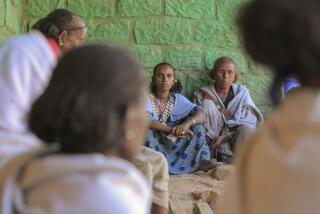Afghans Dig In Amid Drought
- Share via
KANDAHAR, Afghanistan — Abdul Baqi says the “flower” is very difficult to find these days, its life-bearing “root” buried deep beneath the harsh sands and dry, packed earth.
That flower is the moisture that seeps from the upper layers of the water table, the 27-year-old well-driller explains. The root is the deeper, water-rich layer.
Afghanistan’s worst drought in three decades has begun its fourth year. The lack of water has withered farms famous for raisins and pomegranates and devastated herds of nomadic tribes. People must trek for miles carrying plastic jugs over their shoulders to get water at hand-pumped wells.
The American National Ground Water Assn. says the water table in some southern Afghanistan provinces is at an all-time low. Aid groups estimate that more than half of the country’s 25 million people are short of water.
The south has been hit hardest. Already arid, at least three of the five southern provinces -- Kandahar, Helmand and Nimroz -- show signs of turning into deserts.
Before the drought, Baqi’s family-run operation dug just a few wells each year. In the last three years, it has dug 300.
“Without water there is no sign of life. You can see slowly, slowly that the green is finishing. If the drought continues, life will also finish,” Baqi said.
Baqi is digging a well near the mountain slopes on the edge of a desert plain outside Kandahar. He hopes it will provide enough water for a small manufacturing business, but the task is becoming increasingly difficult.
“We dig 100 meters [330 feet] so far and no water,” he said. “Three years ago, the flower was at five meters and the root at 20 meters. Now the flower is at 30 meters and the root at least 100 meters.”
International organizations -- even the U.S. Army -- are digging or planning hundreds of wells around the south.
Among the people suffering the most are the Kuchi, nomadic herdsmen thought to make up about 3% of Afghans. “There are estimates that they have lost up to 70% of their livestock,” said Nigel Pont, program officer for the aid group Mercy Corps.
In a semi-barren field near Kandahar, 60-year-old Hai Abdul Jabar tends nine scraggly sheep. “Before, I was a rich man with more than 300 sheep.... Now I am forced to beg for work in the city,” he said.
The Kuchi herder moved about 60 miles over the last two years to get closer to the city.
Abdul Manan, 47, is an “ab shanaas” -- or water finder, the Afghan version of a dowser. He now has three to four customers daily, mostly farmers. Before, he had at most one customer a week.
With water so hard to find, Manan says he sometimes fails.
“Farmers are suffering the most; their orchards are dying,” he said. “This is a very bad time and I pray to God for rain.”
More to Read
Sign up for Essential California
The most important California stories and recommendations in your inbox every morning.
You may occasionally receive promotional content from the Los Angeles Times.













